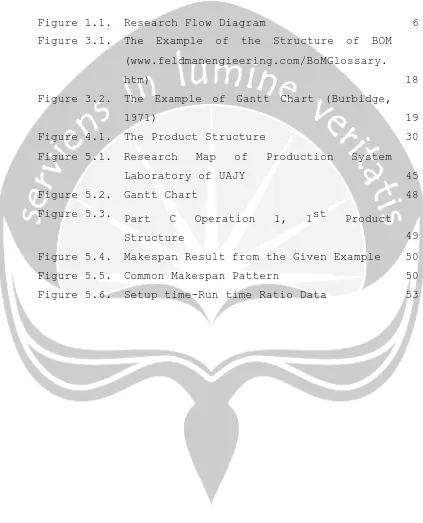THE EFFECT OF LOT SIZE AND PRODUCT STRUCTURE ON MAKESPAN MINIMIZATION IN MULTILEVEL PRODUCT SCHEDULING
(Due to 4 Levels of Product Structure with Maximum Parts Are 4 in Each Level)
THESIS
Submitted as Partial Fulfill of the Requirements to Obtain the Bachelor of International
Industrial Engineering Degree
Arranged by:
SAMMUEL SUKAMTO
Student Number: 04 14 04084
INTERNATIONAL INDUSTRIAL ENGINEERING PROGRAM FACULTY OF INDUSTRIAL TECHNOLOGY
UNIVERSITAS ATMA JAYA YOGYAKARTA YOGYAKARTA
STATEMENT OF WORK’S ORIGINALITY
I honestly declare that this thesis which I wrote does not contain the works or parts of the works of other people, except those cited in the quotations and bibliography, as a scientific paper should.
Yogyakarta, April 2009 The Writer
TEMPORARY APPROVAL
THESIS TITLED
THE EFFECT OF LOT SIZE AND PRODUCT STRUCTURE ON MAKESPAN MINIMIZATION IN MULTILEVEL PRODUCT SCHEDULING
(Due to 4 Levels of Product Structure with Maximum Parts Are 4 in Each Level)
Arranged by : Name : Sammuel Sukamto NIM : 04 14 04084
Adviser, Co-Adviser,
ACKNOWLEDGEMENT
FOREWORD
Thank to God for His blessings and guidance that allow the writer to completely finish the long journey of this final project. This final project is the requirements to obtain the bachelor of International Industrial Engineering Degree in Universitas Atma Jaya Yogyakarta.
The writer realizes that in this final project working, there are plenty of supports and helps from all the people involved. Therefore, in this chance, the writer would like to thank:
1. Mr. Paulus Mudjihartono, S.T., M.T., as the Dean of Faculty of Industrial Technology Universitas Atma Jaya Yogyakarta.
2. Mr. Parama Kartika Dewa, S.T., M.T., as the Head of Industrial Engineering Program Universitas Atma Jaya Yogyakarta.
3. Mr. Hadi Santono, S.T., M.T. as the Head of International Program of Industrial Engineering Universitas Atma Jaya Yogyakarta.
4. Mr. V. Ariyono, S.T., M.T. as the adviser in completing the report.
5. Mrs. Yosephine Suharyanti, S.T., M.T. as co-adviser
in completing the report.
6. All of the lectures and staffs of Universitas Atma
Jaya Yogyakarta, for their knowledge which given to the writer.
7. My parents, for their supports, patience, and
8. My brothers and sister, for their support and prays.
9. IIE Batch 2004, Geo, Eko, Amey, Ellyn, Dewi, Maya,
Yeni, Sugeng, Bram, Yuri, William, lukas, Yansen, Dahana, Vena, Abie, Eliza, Gieta, Desta, Awiek, Andhika, for their assistances, supports, cares, inspirations, funs and loves.
10. All of my friends from IIE all batches and from my workplace GoodNet, for the supports and prays.
11. Michael, Pongky, Hjay, Francis, Simbah, Bontank, Victor, Nungky, Yulia and all of my friends and other people that the writer couldn't mention, for their everlasting friendship, funs, and supports.
The writer realizes that this final project still far from perfect. Therefore, all the critics or suggestions are accepted to make this report better.
The writer hopes that this report will be useful for all people, especially the readers.
Yogyakarta, April 2009
TABLE OF CONTENT
Title Page i
Statement Of Work’s Originality ii
Approval iii
Acknowledgement iv
Foreword v
Table Of Content vii
List Of Tables ix
List Of Figures x
Abstract xi
CHAPTER 1 Introduction 1.1. Background
1.2. Problem Statement 1.3. Research Objectives 1.4. Scope of Research 1.5. Research Methodology
a. Generating Data
b. Data Processing Step c. Analyzing Step
d. Making Report
e. Research Flow Diagram 1.6. Report Outline
1 2 3 3 3 3 4 4 4 4 6
CHAPTER 2 Literature Review 7
CHAPTER 3 Basic Theory 3.1. Scheduling
3.2. Routing File
3.3. Bill of Materials 3.4. Gantt Chart
3.5. Lot Splitting
3.6. Hypothesis Test
3.7. Analysis of Variance (ANOVA)
14 15 CHAPTER 4 Data
4.1. Product Structure
4.2. Routing File 4.3. Lot size
19 20 26
CHAPTER 5 Data Analysis
5.1. Gantt chart simulation
5.2. Ratio Calculation for Minimum Makespan
5.3. Hypothesis Testing using ANOVA
28
34
35 CHAPTER 6 Conclusion and Suggestion
6.1. Conclusion 6.2. Suggestion
41 41
LIST OF TABLES
LIST OF FIGURES
Figure 1.1. Research Flow Diagram 6 Figure 3.1. The Example of the Structure of BOM
(www.feldmanengieering.com/BoMGlossary.
htm) 18
Figure 3.2. The Example of Gantt Chart (Burbidge,
1971) 19
Figure 4.1. The Product Structure 30
Figure 5.1. Research Map of Production System
Laboratory of UAJY 45
Figure 5.2. Gantt Chart 48
Figure 5.3. Part C Operation 1, 1st Product
Structure 49
Figure 5.4. Makespan Result from the Given Example 50
ABSTRACT
Every company has to compete each others to survive in their business world. One of the ways is to reducing the expense cost. A good scheduling can minimize it, because production time equals with production cost. If production takes long time to be done, the production cost needed will be higher. So the scheduling which can minimize makespan is needed. Finding the effect of lot size and product structure on makespan minimization in multilevel product scheduling becomes the main theme of this research that is included in the long term research project of The Production System Laboratory of Universitas Atma Jaya Yogyakarta.
There are some data used in this research, those are product structure (BOM), lot size, setup time, and run time. Product structure used is 4 level of product structure with maximum number of parts are 4 in each level where the combinations of product structure forms are generated to fulfill that consideration. Number of item produced is 45 and lot size evaluated are 5, 9, 15, and 45. Setup time is randomly generated by random number that is varied from 5 to 10 minutes/lot, and run time is varied from 1 to 5 minutes/unit. Optimum lot size is lot size decision giving the minimum makespan. Gantt chart is simulated to obtain the makespan each product structure, lot size and replication. Optimum lot size will be evaluated using ANOVA single factor.

